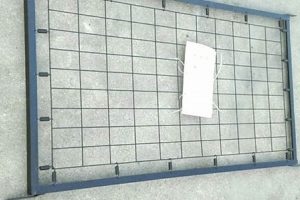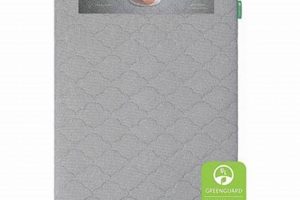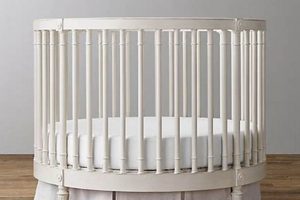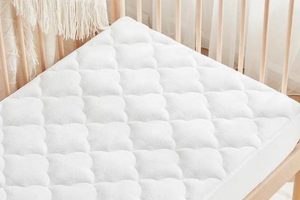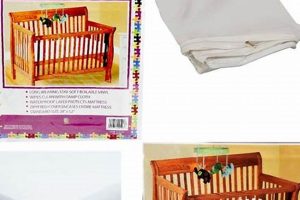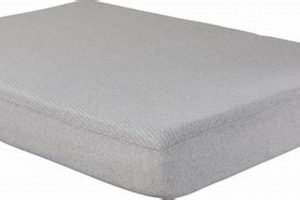This product constitutes a sleeping surface designed specifically for infants within a crib environment. It is a foundational element in creating a safe and supportive sleep space for a baby. These mattresses are engineered to meet stringent safety standards and promote healthy sleep posture for developing infants.
The significance of selecting a suitable infant sleep surface cannot be overstated. A firm, flat mattress is crucial in reducing the risk of Sudden Infant Death Syndrome (SIDS). Additionally, materials used in manufacture can impact the infant’s exposure to potentially harmful chemicals. Choices reflecting environmental awareness often appeal to consumers prioritizing reduced chemical exposure and sustainable practices. Such products may be favored for their contribution to a healthier nursery environment and alignment with eco-conscious values.
The subsequent sections will delve into the specific attributes of these sleep surfaces, encompassing materials, safety certifications, and design considerations. The analysis aims to provide a clear understanding of factors influencing the selection of appropriate infant bedding.
Tips for Choosing a Suitable Infant Sleep Surface
Selecting the appropriate sleep surface for an infant requires careful consideration. Prioritizing safety and healthy development is paramount.
Tip 1: Verify Safety Certifications: Confirm the product meets or exceeds relevant safety standards. Look for certifications from organizations such as CertiPUR-US or GREENGUARD Gold, which indicate testing for harmful chemicals and emissions.
Tip 2: Assess Firmness: Ensure the sleep surface is sufficiently firm. An overly soft surface can pose a suffocation risk. A firm mattress provides the necessary support for the infant’s developing skeletal structure.
Tip 3: Evaluate Material Composition: Scrutinize the materials used in manufacturing. Opt for materials known for their low toxicity and breathability. Organic cotton and other natural fibers can minimize exposure to potentially harmful substances.
Tip 4: Consider Waterproofing: A waterproof surface is essential for hygiene. Look for waterproof options that are free from phthalates and other concerning chemicals. A waterproof barrier protects the mattress core from moisture and prevents the growth of mold and bacteria.
Tip 5: Confirm Proper Fit: Verify the mattress fits snugly within the crib frame. Gaps between the mattress and the crib sides pose a safety hazard. Ensure a tight fit to prevent the infant from becoming trapped.
Tip 6: Maintain Regular Cleaning: Follow the manufacturer’s instructions for cleaning. Regular cleaning helps maintain a hygienic sleep environment and prolongs the lifespan of the product.
A focus on safety certifications, firmness, material composition, waterproofing, and proper fit ensures the infant’s sleep surface supports healthy development and minimizes potential risks.
The subsequent section will provide a comprehensive overview of common misconceptions surrounding infant sleep safety.
1. Firmness
Firmness is a critical attribute of infant mattresses, directly impacting safety and skeletal development. The selection of a sleep surface offering appropriate resistance is paramount to mitigate potential risks associated with infant sleep environments. Therefore, a detailed examination of firmness characteristics is essential when considering an infant sleep surface. This is not the same as mattress for a full bed like a queen or king sized bed.
- Suffocation Risk Mitigation
Excessive softness in an infant mattress presents a potential suffocation hazard. An infant lacking sufficient neck strength may experience difficulty repositioning themselves if their face becomes pressed against a yielding surface. A firmer mattress reduces the likelihood of such an occurrence, providing a more stable and secure sleep environment. This is especially true when a swaddle is used.
- Skeletal Support and Development
An appropriately firm surface offers essential support for the infant’s developing musculoskeletal system. Adequate support helps maintain proper spinal alignment and reduces the risk of positional deformities. Inadequate firmness can contribute to discomfort and potentially hinder healthy skeletal growth. This is not a pillow top mattress and should not be soft.
- Safety Standard Compliance
Established safety standards for infant mattresses mandate specific firmness levels. These standards, often enforced by regulatory bodies and certification organizations, aim to ensure that commercially available mattresses meet minimum firmness requirements. Adherence to these standards provides a baseline level of safety and quality assurance. Some sources say to test by trying to make an indention with your hand; the mattress should spring back.
- Material Composition and Density
The inherent firmness of a mattress is directly influenced by its constituent materials and their density. High-density materials, such as certain foams and fiber blends, generally contribute to greater firmness. Conversely, low-density materials tend to result in a softer, more pliable surface. The careful selection and combination of materials are crucial in achieving the desired firmness level in an infant mattress. Check that the crib mattress is dense and of high quality.
The interplay between suffocation risk mitigation, skeletal support, safety standard compliance, and material composition underscores the significance of firmness in infant mattress design. Consideration of these facets when selecting an infant sleep surface is essential to promoting a safe and developmentally supportive sleep environment. These facets combined, provide insight into the quality of an infant sleep surface.
2. Material Safety
Material safety is of paramount importance in the selection of infant sleep surfaces. The composition of these products directly impacts an infant’s potential exposure to harmful chemicals, allergens, and irritants. Consequently, rigorous scrutiny of materials is essential to ensuring a safe and healthy sleep environment.
- Chemical Emissions
Infant mattresses constructed with certain synthetic materials may emit volatile organic compounds (VOCs). These compounds can contribute to indoor air pollution and potentially trigger respiratory issues or allergic reactions in sensitive infants. Low-VOC or VOC-free materials, such as those certified by GREENGUARD Gold, mitigate this risk by limiting the release of harmful emissions. Examples of materials with reduced VOCs include plant-based foams and sustainably sourced natural fibers. This provides an important safety standard and reduces the effects of potential air pollution.
- Flame Retardants
Traditional flame retardants used in bedding products have been linked to various health concerns. Some manufacturers now utilize alternative flame retardant methods, such as inherently flame-resistant materials like wool or silica, or employ barrier fabrics that eliminate the need for chemical treatments. Choosing mattresses that forgo potentially harmful chemical flame retardants minimizes an infant’s exposure to these substances and their associated health risks. Always check the manufacturer’s labeling to confirm the absence of potentially harmful materials. Look for mattresses with alternative materials for the surface of the foam core for added safety.
- Allergen Content
Infants with allergies or sensitivities may react to certain materials commonly found in mattresses, such as latex or certain dyes. Opting for hypoallergenic materials, such as organic cotton or hypoallergenic synthetic fibers, reduces the likelihood of triggering allergic reactions. Regular cleaning and the use of a mattress protector can further minimize allergen exposure. Selecting hypoallergenic products are especially important for those with documented allergies to certain material types such as wool, latex and other common allergens.
- Phthalate and Heavy Metal Content
Phthalates, often used in the production of plastics and vinyl, have been linked to endocrine disruption. Heavy metals, such as lead and mercury, can pose neurodevelopmental risks. Choosing mattresses certified to be free of phthalates and heavy metals safeguards against exposure to these harmful substances. Certifications like OEKO-TEX Standard 100 guarantee that the product has been tested for a wide range of harmful substances. A mattress’s construction type may also pose danger to children such as suffocation. All mattresses should conform to the size requirements to prevent gaps between the mattress and crib.
The meticulous assessment of material composition allows caregivers to make informed choices, prioritizing infant health and safety. Selection criteria should emphasize low-emission, hypoallergenic materials free from harmful chemicals, mitigating potential risks associated with material exposure. Considering these factors is crucial in creating a healthier and more secure sleep environment for infants, with peace of mind for parents and caretakers.
3. Waterproof Design
The incorporation of a waterproof design in an infant sleep surface significantly contributes to hygiene, durability, and overall safety. This feature provides a crucial barrier against moisture penetration, mitigating the risk of bacterial growth and preserving the integrity of the underlying materials.
- Hygiene Maintenance
Infants are prone to spills, drool, and diaper leaks. A waterproof surface prevents these fluids from permeating the mattress core, hindering the growth of mold, mildew, and bacteria. This is critical in maintaining a clean and hygienic sleep environment for the infant, reducing the risk of skin irritation and respiratory issues.
- Durability Enhancement
The presence of a waterproof layer protects the internal components of the mattress from moisture damage. This extends the product’s lifespan by preventing deterioration of the foam or fiber core, ultimately providing long-term value to the consumer. Without this protection, the mattress can quickly become unusable due to irreversible damage from moisture.
- Ease of Cleaning
Waterproof surfaces simplify cleaning procedures. Spills can be easily wiped clean with a damp cloth, eliminating the need for harsh chemicals or extensive cleaning processes. This contributes to convenient maintenance and minimizes the risk of introducing potentially harmful cleaning agents into the infant’s sleep environment.
- Material Protection
Waterproof crib mattresses have a waterproof material as an outer layer to protect the product and prevent liquid from getting in. As a result, this ensures that dust mites cannot penetrate the mattress core, helping keep a clean and sanitary surface.
The integration of a waterproof design represents a fundamental aspect of a well-designed infant sleep surface. By addressing hygiene concerns, enhancing durability, and simplifying cleaning procedures, this feature contributes significantly to the creation of a safe and healthy sleep environment for the infant.
4. Proper Fit
The correct fit of an infant mattress within a crib is a foundational safety consideration. A secure fit minimizes potential hazards and ensures the sleep environment is conducive to infant well-being. The dimensions of the “lullaby earth crib mattress” relative to standard crib sizes are, therefore, a critical point of evaluation.
- Gap Prevention
Gaps between the mattress edge and the crib frame represent a significant entrapment risk. An infant can become wedged in these spaces, leading to potential suffocation or injury. A “lullaby earth crib mattress” designed with precise dimensions minimizes these gaps, adhering to recommended safety guidelines. Consistent sizing across production is paramount to ensuring uniform gap prevention.
- Standard Compliance
Regulated standards define acceptable tolerances for crib and mattress dimensions. Adherence to these standards ensures interoperability and minimizes the risk of mismatch. The “lullaby earth crib mattress” must conform to these established norms, guaranteeing compatibility with standard-sized cribs. Certification from relevant safety organizations verifies this compliance.
- Stability and Support
A properly fitting mattress provides stable support for the infant. Excessive movement or shifting of the mattress within the crib can compromise sleep quality and potentially create unsafe conditions. The “lullaby earth crib mattress,” when correctly sized, remains firmly in place, offering consistent support and reducing the risk of instability.
- Longevity and Performance
An ill-fitting mattress can experience premature wear and tear. Constant friction against the crib frame can damage the mattress cover and compromise its structural integrity. A “lullaby earth crib mattress” that fits snugly within the crib is less susceptible to this type of damage, ensuring long-term performance and maintaining its intended safety features.
The interlocking elements of gap prevention, standard compliance, stability, and longevity underscore the critical importance of proper fit. A “lullaby earth crib mattress” engineered to meet these requirements offers a safer and more supportive sleep environment for the infant, enhancing parental peace of mind.
5. Certification Standards
Certification standards play a critical role in evaluating and validating the safety, quality, and environmental impact of infant mattresses. These standards provide a framework for manufacturers to adhere to, ensuring their products meet specific benchmarks for performance and material composition. For the “lullaby earth crib mattress,” adherence to these standards is not merely a marketing claim but a tangible demonstration of commitment to infant safety and well-being.
- GREENGUARD Gold Certification
This certification indicates that a “lullaby earth crib mattress” has been tested for chemical emissions and VOCs, ensuring that it contributes to healthier indoor air quality. Mattresses bearing this certification have been shown to emit lower levels of harmful substances, reducing the risk of respiratory irritation and other health concerns for infants. This is vital, considering infants spend a significant portion of their time sleeping and are more susceptible to the effects of chemical exposure.
- CertiPUR-US Certification
The CertiPUR-US certification applies to the foam components used in a “lullaby earth crib mattress,” verifying that they are made without certain harmful chemicals, such as ozone depleters, PBDE flame retardants, mercury, lead, and formaldehyde. It also confirms that the foam has low VOC emissions. This certification provides assurance that the mattress’s foam core meets stringent environmental and health standards.
- Organic Material Certifications (e.g., GOTS)
If a “lullaby earth crib mattress” incorporates organic materials like cotton or wool, certifications like the Global Organic Textile Standard (GOTS) confirm that these materials have been sourced and processed according to strict environmental and social criteria. This certification guarantees that the organic fibers used in the mattress are free from harmful pesticides and chemicals, promoting a more natural and sustainable sleep environment for the infant.
- JPMA Certification
The Juvenile Products Manufacturers Association (JPMA) certification signifies that a “lullaby earth crib mattress” has undergone rigorous testing to meet or exceed safety standards established by ASTM International. This certification covers aspects such as mattress firmness, flammability, and overall structural integrity, providing assurance that the product is designed and manufactured with infant safety as a top priority.
These certifications, when present on a “lullaby earth crib mattress,” offer consumers a clear and verifiable basis for assessing the product’s safety and environmental attributes. By prioritizing mattresses with recognized certifications, caregivers can make informed decisions that minimize potential risks and promote a healthier sleep environment for their infants. The pursuit and attainment of these certifications reflect a manufacturer’s dedication to exceeding minimum standards and providing a product aligned with best practices in infant care.
Frequently Asked Questions about Infant Sleep Surfaces
The following addresses common inquiries concerning safe and appropriate sleep surfaces for infants. These answers provide guidance based on established safety recommendations and industry best practices.
Question 1: What level of firmness is recommended for an infant mattress?
A firm surface is essential for infant sleep. Overly soft mattresses pose a suffocation risk. The mattress should be firm enough to maintain its shape under the infant’s weight, preventing indentation.
Question 2: What materials should be avoided in an infant mattress?
Materials containing phthalates, chemical flame retardants, and excessive VOCs should be avoided. Opt for mattresses with certifications indicating low chemical emissions and the absence of harmful substances.
Question 3: Is a waterproof mattress necessary for infant sleep?
A waterproof surface is highly recommended to protect the mattress core from fluids and prevent bacterial growth. Waterproofing should be achieved with materials that are free from harmful chemicals.
Question 4: How should an infant mattress be cleaned and maintained?
Regularly wipe down the mattress surface with a damp cloth. Avoid harsh chemicals or abrasive cleaners. Follow the manufacturer’s instructions for specific cleaning recommendations.
Question 5: What certifications should one look for when purchasing an infant mattress?
Seek certifications such as GREENGUARD Gold, CertiPUR-US, and GOTS. These certifications indicate the mattress has been tested for chemical emissions, material safety, and organic content, respectively.
Question 6: How important is the fit of the mattress within the crib frame?
A snug fit is crucial. Gaps between the mattress and the crib sides can pose an entrapment hazard. Ensure the mattress dimensions match the crib specifications.
Prioritizing firmness, material safety, and proper fit are fundamental aspects of selecting a safe and appropriate infant sleep surface. Adherence to certification standards provides added assurance of product quality and safety.
The subsequent discussion will elaborate on common misconceptions surrounding infant sleep practices.
In Summary
This examination of the “lullaby earth crib mattress” has underscored the crucial elements of safety, material composition, and design that define a suitable sleep environment for infants. Firmness, verified certifications, and a secure fit within the crib frame emerged as paramount considerations. The presence of potentially harmful substances, such as VOCs and phthalates, demands careful scrutiny of product specifications and manufacturing processes. The waterproof design, while essential for hygiene, must not compromise material safety through the introduction of questionable chemicals.
The selection of an infant sleep surface necessitates diligent research and a commitment to informed decision-making. It is imperative to prioritize products that demonstrably adhere to stringent safety standards and prioritize the well-being of the infant. Continued vigilance in monitoring emerging research and evolving safety guidelines will ensure that caregivers remain equipped to provide the safest possible sleep environment for their children. This responsibility extends beyond a single purchase, requiring ongoing evaluation of product performance and adherence to recommended maintenance practices.


